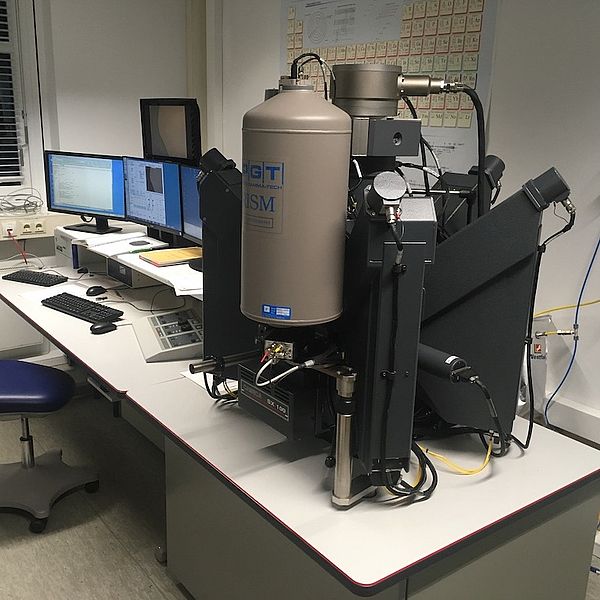...is a highly spatially resolved and non-destructive method for the analysis of elemental concentrations in geological and other samples.
[Translate to English:] Elektronenstrahlmikroanalytik
How it works
In the electron beam microprobe, electrons are generated by means of a tungsten cathode and accelerated by high voltage onto a sample. Due to the interaction of the sample with the electron beam, characteristic X-rays are generated and their intensity is measured. By comparison with measurements of standard reference materials, the concentration of elements in the sample is calculated. All elements from atomic number 5 (boron) can be detected in principle. In addition to quantitative analyses, element distribution maps as well as secondary electron and backscattered electron images (as with a scanning electron microscope) can be generated.
The device
The microprobe at the Department of Geosciences at the University of Bremen is a Cameca SX100, which was previously operated at the Institute of Mineralogy at the University of Hannover. The instrument is equipped as follows:
- EDX system (energy dispersive spectrometer) from IXRF with Si(Li) detector from Princeton Gamma Tech
- Five wavelength dispersive spectrometers with the following crystal configuration:
- Sp1: PET, TAP, PC1, PC2
- Sp2: LPET, LLIF
- Sp3: LPET, LLIF
- Sp4: PET, TAP, PC2, PC3
- Sp5: PET, TAP, PC0, PC3
- Secondary electron detector
- Backscattered electron detector
- Optical zoom microscope with polarizer/analyzer and camera
- Software PeakSight 6.2
Specimen requirements
Specimens must have a flat and highly polished surface and be vacuum resistant. Possible specimen formats are thin sections in "Gießener" format (28 x 48 mm) or 1-inch mounts (25 mm diameter, 4-10 mm high). Prior to the analyses, the samples become coated with carbon. As calibration standards the complete Smithsonian National Museum of Natural History series (Jarosewich et al. 1980), USGS glasses, and other silicates and sulfides are available.
We thank the Institute of Mineralogy of the University of Hannover (Prof. François Holtz) for the generous donation of the microprobe.

